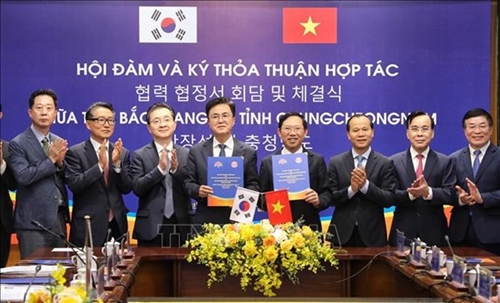Speaking at the event, Chairman of the provincial People's Committee Le Anh Duong said the RoK now ranks first in terms of the number of projects and second in investment capital among 30 countries and territories investing in Bac Giang.
In particular, Bac Giang has the Vietnam-Korea Vocational College of Technology, which effectively contributes to the goal of developing a skilled workforce that meet the requirements of the local industrial sectors and Korean businesses in Vietnam.
    |
 |
|
At the talks and cooperation agreement signing ceremony |
At present, Bac Giang has 1,750 workers employed in the RoK, and nearly 1,200 Korean workers are working in the province. Cultural and economic exchanges between Bac Giang and the RoK are increasingly expanding.
The RoK is the second largest export-import market of Bac Giang, with bilateral trade turnover totaling 13.3 billion USD last year, up 46.2% annually. In the first 11 months of this year, the figure reached around 14.8 billion USD, or 31.2% of the province's total export-import turnover.
Bac Giang exported various goods to the RoK, including apparel, leather and footwear, computers, electronic products and components, phones and accessories, processed and fresh farm produce. It imported raw materials and accessories for apparel, leather and footwear, computers, electronic products and components, phones and accessories, machinery and equipment, processed and fresh farm produce from the RoK. The import turnover from the RoK accounted for 35.5% of the province's total.
Governor of Chungcheongnam province Kim Tae-heum expressed his hope that diplomatic ties between the two localities will be further strengthened both in depth and width.
After the talks, the two sides signed a cooperation agreement on the regular exchange of delegations to share managerial experience, cultural exchanges to raise understanding of each other's history and culture, economic cooperation in industrial and agricultural development, and collaboration in the fields of health care, education, training, high-quality human resources and labor exchange, among others.
Source: VNA